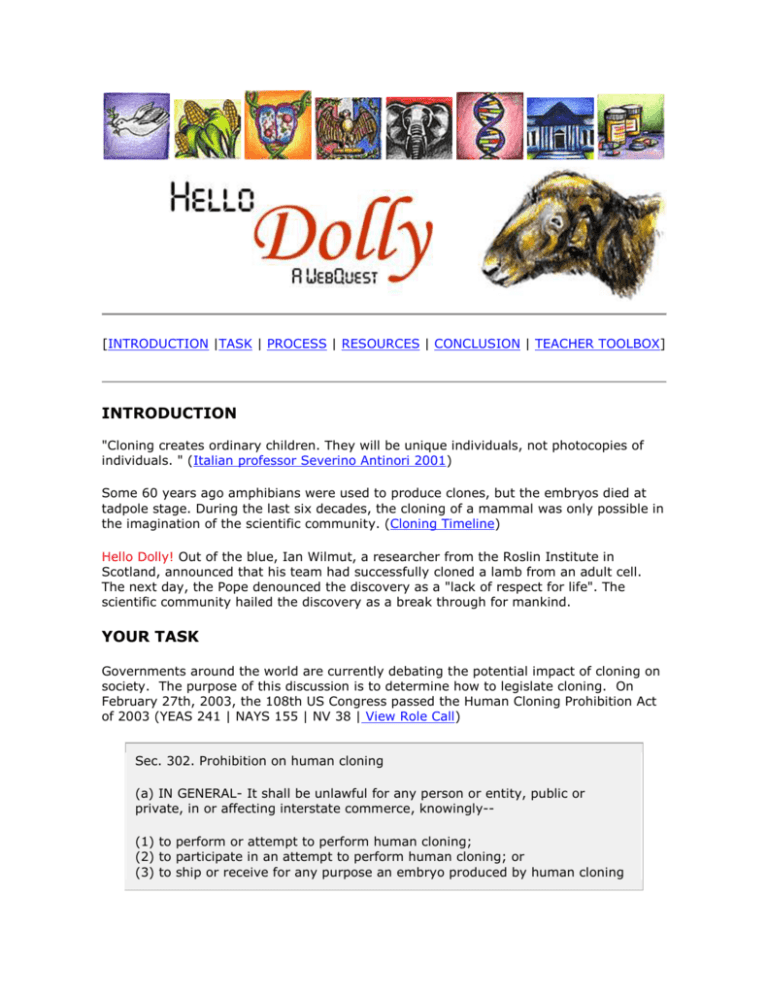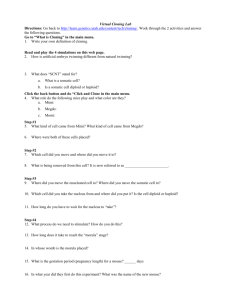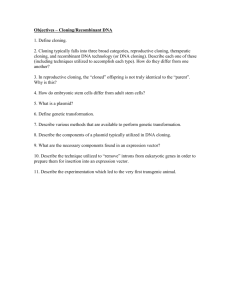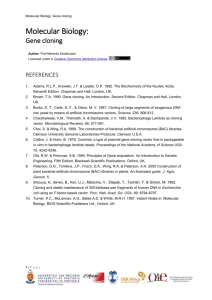
[INTRODUCTION |TASK | PROCESS | RESOURCES | CONCLUSION | TEACHER TOOLBOX]
INTRODUCTION
"Cloning creates ordinary children. They will be unique individuals, not photocopies of
individuals. " (Italian professor Severino Antinori 2001)
Some 60 years ago amphibians were used to produce clones, but the embryos died at
tadpole stage. During the last six decades, the cloning of a mammal was only possible in
the imagination of the scientific community. (Cloning Timeline)
Hello Dolly! Out of the blue, Ian Wilmut, a researcher from the Roslin Institute in
Scotland, announced that his team had successfully cloned a lamb from an adult cell.
The next day, the Pope denounced the discovery as a "lack of respect for life". The
scientific community hailed the discovery as a break through for mankind.
YOUR TASK
Governments around the world are currently debating the potential impact of cloning on
society. The purpose of this discussion is to determine how to legislate cloning. On
February 27th, 2003, the 108th US Congress passed the Human Cloning Prohibition Act
of 2003 (YEAS 241 | NAYS 155 | NV 38 | View Role Call)
Sec. 302. Prohibition on human cloning
(a) IN GENERAL- It shall be unlawful for any person or entity, public or
private, in or affecting interstate commerce, knowingly-(1) to perform or attempt to perform human cloning;
(2) to participate in an attempt to perform human cloning; or
(3) to ship or receive for any purpose an embryo produced by human cloning
or any product derived from such embryo.
(b) IMPORTATION- It shall be unlawful for any person or entity, public or
private, knowingly to import for any purpose an embryo produced by human
cloning or any product derived from such embryo.
(c) PENALTIES(1) CRIMINAL PENALTY- Any person or entity that violates this section shall
be fined under this title or imprisoned not more than 10 years, or both.
(2) CIVIL PENALTY- Any person or entity that violates any provision of this
section shall be subject to, in the case of a violation that involves the
derivation of a pecuniary gain, a civil penalty of not less than $1,000,000 and
not more than an amount equal to the amount of the gross gain multiplied by
2, if that amount is greater than $1,000,000.
(d) SCIENTIFIC RESEARCH- Nothing in this section restricts areas of scientific
research not specifically prohibited by this section, including research in the
use of nuclear transfer or other cloning techniques to produce molecules,
DNA, cells other than human embryos, tissues, organs, plants, or animals
other than humans.'
Mr. Weldon's proposed bill only addresses the cloning of humans. Placing a ban on all
cloning activity would be easy, but it may prove to be very short sighted. Cloning
technologies may have a profound impact on society in the 21st century. Cloning
research has the potential to impact:
World Hunger
Infertility
Economics
Immortality
Animal Rights
Disease Treatment
Scientific Research
Overpopulation
Your task will be to ask good questions, access current information, analyze the validity
of sources, reach consensus with your peers, take action, and explain the consequences.
All in an effort to answer one primary question:
What government policy should be established to regulate cloning?
Keep an open mind, and try not to reach a conclusion before your investigation is
complete. You will be assessed on how you process information, support your point of
view, communicate effectively, and collaborate with your peers. Good Luck!
THE PROCESS
The United States House of Representatives is assembling a group of specialists to
investigate the wide spread implications of cloning on the social, economic, and political
fabric of American society. Each specialist team will present their findings during a
Cloning Summit. It will be the responsibility of the team members to evaluate the
proposed Human Cloning Prohibition Act, and determine if the bill should be expanded to
include other types of cloning research.
Step 1: Dr. Frankenstein, I Presume?
Step 2: Walking a Mile in My Shoes
Step 3: The Cloning Summit
Step 4: Building Consensus
Step 5: Tell the World
Step 1: DR. Frankenstein, I Presume?
What is all the commotion about? Andrew Ross, managing editor for Salon Magazine,
posed several questions to Dolly's creator Dr. Ian Wilmut. The questions focus on many
of the hopes and fears about human cloning. Get together with your teammates, and
visit DR. FRANKENSTEIN, I PRESUME?
As a group, determine how to attack the following small activity.
Use the interview to identify three hopes and three fears about human cloning.
Craft three additional questions that your group would ask Dr. Wilmut.
Step 2: Walking a Mile in My Shoes
Now it’s time to look at cloning from several different perspectives. Each perspective has
it's own point of view, and offers a unique solution to the complex problems that frame
cloning.
Each classroom team will be assigned a role. To make sure your team members fully
understand their roles, open the dossiers below to learn about each group's
responsibilities. After you have explored each role, open the role your group has been
assigned, and start your quest.
Stem Tech
Institute of
Theology and Ethic
A San Diego biotech firm that
specializes in embryonic stem cell
research.
An international group of theologians of
various ideologies.
US Senator
A group of distinguished senators
gathered together to analyze the
Human Cloning Prohibition Act.
Friends of Animals
A nationally recognized group of
citizens that promote the humane
treatment of animals.
Roslin Institute Team
Professors
of Biomedical Ethics
A group of devoted scientists that
cloned a sheep; Dolly. Their role will be
to explain cloning.
A few of the nation's top scholars of
biomedical ethics.
US Department of Agriculture
An expert scientific team that will focus
on the benefit of cloning on the nation's
food supply.
CLN Pharmaceutical
A company committed to the
advancement of pharmaceutical
products using cloning. A main
contributor to the original Dolly cloning
experiment.
Step 3: The Summit
It is time for your team to share what it has learned about cloning. You have become an
expert on your role's point of view, and the people attending the Cloning Summit need
to learn about cloning from your perspective. Your team will be given ten minutes to
explain how the proposed Human Cloning Prohibition Act should be expanded or
maintained, and you must explain your reasoning. Pictures, video & audio clips, and
quotes from your research can only strengthen your presentation.
It is your job to present your perspective effectively. If you choose to do a PowerPoint
presentation, it is your responsibility to make sure the program will work before the day
of the Cloning Summit. If you are not using PowerPoint, you may create a butcher paper
mural, or you may choose to create a video presentation. Be creative. You may want to
take a quick look at a possible grading rubric that describes a excellent presentation.
Audience Responsibilities
As a member of the Cloning Summit Audience, your job is to listen carefully to each
presentation. You will be called upon to participate on a Summit Subcommittee that will
ultimately decided how the government should proceed. While listening to the other
perspectives:
1. Write down the other role's "Big Question."
2. Create a list of points your role would support and reject.
Step 4: Take a Stand
Several separate Summit Subcommittees have been established to develop a
recommendation on how the government should proceed. Each Subcommittee should
consist of one expert from each role, so developing a recommendation will not be an
easy task. What's good for science research may not be good for animal rights or
religious beliefs. You must discuss, persuade, argue, deal, and brainstorm a plan of
attack. You will not all agree on the best way to present your action plan, but you must
reach a consensus. You may find that you must agree to disagree in order to find the
best solution.
A separate "Take A Stand" activity has been created to assist your subcommittee in
creating an action plan.
Step 5: Tell the World
Your final responsibility will be to share your Cloning Summit Subcommittee report with
a "real-world" contact. This will give you the opportunity to receive feedback from an
expert that has not been part of the project. [Possible Grading Rubric]
First, you must find a contact. You may remember an email contact in one of your
research artifacts. You might want to surf through the resources again, and look for an
email contact. Your group might also consider sending your recommendations to a
government official. In which case, you can find a list of email addresses at:
Email The White House
Email A US Senator
Email A US House of Representatives Member
Write an introduction to your email that will provide your contact with the background
information they will need to understand your recommendations. Be sure to tell your
contact that you are seeking feedback. Cut and paste your Take A Stand report into the
body of the email or send your report as an attachment.
Make sure that all the members in your group have proof read the email message
before sending it.
Send your email. Make sure that you 'cc' (carbon copy) your teacher, so that he
or she has a copy of your work.
CONCLUSION
Cloning may be the most important scientific discovery of the current century, and its
impact will be felt long into the next century.
"Most human events go through three phases of growth. First is the fear and
abhorrence, and the second phase is sort of a tolerance, acceptance, and passivity, and
the third phase is enthusiastic endorsement." (Dr. Richard Seed)
It's time for our students to take a stand and tell the world what they believe.
Launched April 1997, Updated March 2003
copyright © 1995-98 Keith Nuthall
Poway Unified School District
all rights reserved








